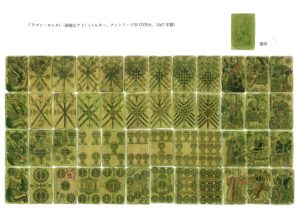3. Turn of ‘dragon cards’ made in Antwerp
In 2021, studies on the elusive Namban Carta entered a new stage with the discovery of new historical material. The breakthrough came in January, when the Nationaal Museum van de Speelkaart in Belgium made its collection available digitally, uploading its images on the Internet for viewing by the public across the globe. We are grateful for the digitalisation of historical studies, which has progressed rapidly since the turn of the century and made this possible.
To our surprise, the digitalised collection included an image of 44 dragon cards produced in Belgium in 1567, just about the time when Namban Carta came to Japan. It is true that Tratado do Jogo do Boston. Com a Historia das Cartas de Jogar10, a book written by Portuguese author Henriques da Silva and published in 1942, had referred to those cards, which were kept in Portugal at that time. But we did not know how they looked because the book did not contain any images of the cards. The cards were then procured by a French collector who kept them secret for a long time. Although the Nationaal Museum van de Speelkaart bought the cards directly from the collector in 2005, it kept them private until digitalising its collection.
In the history of playing cards, it is very rare for cards that were used 500 years ago to have been conserved to the present day. In most cases, only a few cards remain out of the complete set of 48. By contrast, the existence of 44 dragon cards is miraculous, because it effectively enables the restoration of all 48 cards of the whole set. In the present case, the remaining cards include the dragon-decorated aces of all four suit marks: Paus, Espadas, Copas and Ouros. This invaluable material evidence also reveals the characteristics of the cards — size, weight, pattern, iconographic design and pigments used. Descriptions found in the image include the name of the producer and the year of production. Furthermore, we can observe artwork and designs on the back side of the cards. Undoubtedly, this was the discovery of the century for researchers of the history of playing cards.
¹⁰ Henriques da Silva, “Tratado do Jogo do Boston. Com a Historia das Cartas de Jogar”, Prefacio de Egas Moriz. Ed. Afica, Lisbon, 1942, p.34-35.










